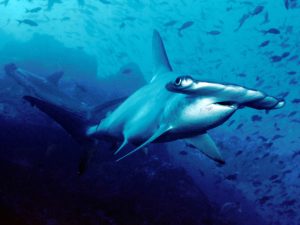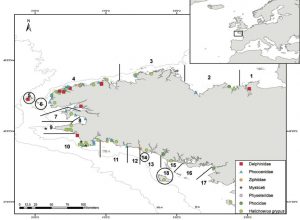Fishes that rule the world: circumtropical distributions revisited
By William Evans, SRC Intern
Fishes that rule the world: circumtropical distributions revisited (2015) by Gaither, Bowen, Rocha, and Briggs reviews and updates the list of circumtropical fishes that was published in1960. The term circumtropical is defined by Merriam-Webster dictionary as “surrounding or distributed throughout the tropics”. Circumtropical fishes represent less than 1% of the world’s aquatic vertebrates but are a diverse group that includes common species such as tuna, remoras, sharks and lantern fishes.

“Nurse shark with remoras” by Duncan Wright (User:Sabine’s Sunbird) – en: Image:Nurse shark with remoras.jpg. Licensed under CC BY-SA 3.0 via Wikimedia Commons
A majority of these species are pelagic or bathypelagic. Through recent updates in technology and the availability to access information using resources like Fishbase and the Catalogue of Fishes, the list was updated from the original 107 species from 1960 to 284 species. The scientists were not only able to use online resources but also used DNA sequencing technologies to better comprehend specific genetic lineages, opposed to only using morphology. Although morphology is a tool that most scientists use in the field, there is room for error, especially with species with such close lineages like the great hammerhead and the scalloped hammerhead. By using DNA barcoding, they were able to compile a more accurate list of when a previously listed species was actually more than one.
The researchers searched FishBase from June to December of 2014 to primarily analyze the distribution of the 107 fishes on the original list. Species were removed if they were only found in the southern ocean and subtropical convergences. After using FishBase, they used the Shorefishes of the Tropical Eastern Pacific (EP) and other records. From these searches, species listed as “circumglobal” were removed, as well as species that have no present records in the East Pacific. Google Scholar searches were also used to discover genetic information from using simple searches of the species name, common name, followed with “genetic” or “molecular” and the first 50 results were then analyzed. A search in the Barcode of Life Data System (BOLD) was also used to record sequences and bins for each species for further examination. Many of the species added were bathypelagic (73% of the 196 new species added) and 19 taxa were removed from the original list. Some of the organisms had no or limited genetic data, showing that many species have not been assessed using these current genetic coding tools.
There are some challenges that exist when it comes to creating and editing a list as extensive as this one. One is the availability of information. Cryptic species, ones with difficultly-distinguishable features, can be a problem when doing a biodiversity study. Although some cryptic species, like the scalloped hammerhead, have a plethora of genetic data, others do not. Of the current list, 74% of the species do not have genetic data, which means that the list could be more accurate if more data was available.
The journal discusses some biological factors that can explain the global distribution of the fishes found on the list. These factors include a vagile adult phase, a long pelagic duration, habitat preference, and old lineages. In addition to biological factors promoting distribution, there are factors that inhibit global distribution. Those mainly include the East Pacific Barrier and the thermal regime. The East Pacific Barrier is defined as a 4000 km to 7000 km region of deep ocean that separates the East Pacific from the Central Pacific which demonstrates the largest divide in circumtropical fauna that inhabit shallower waters. The thermal regime defined as an area off of South Africa with a topographically and hydrologically complex area mainly due to the cooler Benguela Current that moves northward that is deemed lethal to many tropical organisms.
Although the list has been updated to better represent the amount of circumtropical fish species, a majority of the organisms on this list have little to no genetic data, displaying a disconnect in the amount of information that we know. The authors note that as technology advances, more of the ocean is explored, and more studies are done, the list will be modified to thus reflect those changes.
References:
Gaither, M. R., Bowen, B. W., Rocha, L. A. and Briggs, J. C. (2015), Fishes that rule the world: circumtropical distributions revisited. Fish and Fisheries. doi: 10.1111/faf.12136



